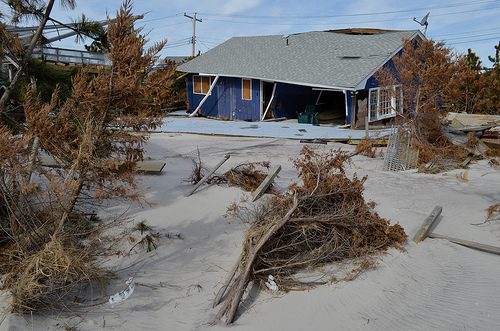
A Fire Island, N.Y., home destroyed by Hurricane Sandy. Photo by North Atlantic Division for flicker, CC BY 2.0
“Self interest generalized is community interest” — Kenneth Jones, community organizer
Throughout my experience in leading NeighborWorks America’s Superstorm Sandy response, two critical aspects have continually been present: people-based and place-based needs. These themes lie at the heart of community development today.
While it sometimes seems the strategies attending these needs are at odds with each other, the cross-sector response to Sandy—as represented by the various agencies that were part of the Federal Hurricane Sandy Re-Building Task Force, working in tandem with elements of the National Disaster Recovery Framework—demonstrates that a response to these needs does not present a mutually exclusive set of options. In the aftermath of Sandy, while continual improvement is an ongoing learning process, there has been much progress made toward a coordinated and linked response (largely led by government) that considers both sets of needs at the same time, acknowledging individual personal situations as well as the physical places where people live.
However, people do live in specific places, and we need to also look at the ways in which people influence the make-up, character, and social fabric of the places that we occupy. If you take the people out of the place, it becomes a different place from a socioeconomic and cultural perspective.
An opportunity—and challenge—that has caught my attention working through the aftermath of community crisis is the potential ongoing role, position and capacity of community-based community development organizations to nurture, promote and sustain resident leadership. Such leadership serves as necessary social capital to connect individual and collective needs and aspirations through a community planning response before, during and after a disaster—house by house, block by block, neighborhood by neighborhood. I have always been keenly taken by the relationship of self to other, and of private to public.
Jeremy Nowak, thought leader and former head of The Reinvestment Fund and the William Penn Foundation, once shared with me the observation that there are three predominant values in the United States:
1) please leave me alone,
2) mind your own business, and
3) in a crisis here is a helping hand.
That conversational tidbit has stayed with me in the context of building community and engaging in community development endeavors, since it speaks to the challenge of fostering communitarian values within a society that promotes individualism as a bedrock principle. And as we rapidly experience worldwide technological and socio-economic changes that foster true global reach, with increasing opportunities (and pressures) that promote mobility, our whole concept of community is changing—notwithstanding the “activist” and “green” saying to “think global, act local”!
Affinity groups become community. Virtual networks become community. Our neighborhood may or may not be how we define community. More so, our sense of self (as individual beings) and our relationship to others (per what may be considered our “social” being) is quickly changing. These dynamics are important contextual considerations to acknowledge as we develop community emergency response plans and expect that our well thought-out and outlined action steps will actually produce the intended results.
NeighborWorks America is continuing to develop training efforts that support communities in addressing disaster response needs in a holistic and practiced manner. Since mid-December 2012, we have directly reached 951 participants through local trainings that support housing counselors and case managers with tools and resources to guide residents in decision-making on how to navigate the road to housing recovery and help residents, counselors, and contractors to be more aware of specific issues—such as the hazards of mold—that must be addressed when dealing with flood-related disasters.
We are now crafting the curriculum content that positions neighbors in the emergency response delivery system as volunteer leaders, with the knowledge and capacity to provide urgent responses in the wake of community disaster. As we frame our training modules, we are mindful from our experience that the most sustainable community-building initiatives come from a well-organized, enthusiastic and accountable group of neighborhood residents, and that individuals can learn and gain skills to better equip themselves to facilitate capacity building in communities and to take a leadership role in decision-making for their neighborhoods.
As community-based entities, we are uniquely positioned to connect to and nurture constituencies to act collectively as social entities within our societal and civic participation structures. To achieve this end, we need to pay attention and learn how to meaningfully engage with others (and dare I add—to appreciate that communication is not just a magical technical construct that happens as we learn how to read, write and speak; rather, it is a “social” skill—and emotional intelligence is very embedded in this learning and practice!).
One emerging opportunity for a community based community development organization is to be positioned in what Chris Kui, executive director of Asian Americans for Equality (AAFE), a NeighborWorks chartered member organization, calls the “social firehouse” role. AAFE’s most signature community planning initiative came in the wake of the September 11, 2001, World Trade Center attack. In the aftermath of that tragedy, AAFE played a conduit role between frightened residents and government agencies, and initiated and spearheaded a “Rebuild Chinatown Initiative” through which community members and stakeholders were engaged regarding their concerns for and viewpoints of their neighborhood’s future. AAFE then drafted concrete recommendations which became action items that were implemented over time. With the additional recent experience of Sandy, and through discussions with Kui and other community leaders, it is clear that locally based organizations such as community development corporations (CDCs) can fill a need to engage residents before, during, and after a crisis.
This means supporting residents not just with the prescriptive knowledge of the “who, where, when, and what to do” in putting together a detailed crisis management plan before a disaster hits, but also to support a shared practice on how to communicate and connect with each other and engage from a place of trust to find meaningful ways to relate to each other, in calm times as well as during and immediately after a disaster hits. It also means—and all of this needs to be culturally and class sensitive—how we engage (emotionally and intellectually) with each other and communicate with positive intent to uplift our individual unique gifts and talents and voices to make the diverse quilt that represents all of us into the more perfect union of a shared inclusionary community vision.
One last comment: Recent social research has shown that communities with well-organized social networks in place before a disaster tend to recover more swiftly and with less fragmentation afterward. Communities that are less coordinated socially before a disaster tend to take longer to recover and demonstrate less resiliency. This tells us that the nonprofit community-based community development organization can fill a gap in targeted areas by serving as the social network weaver (or “social firehouse”) promoting social capital through purposeful training and intervention activities that allow for skill building and collaborative community planning. So why does it take a disaster to bring us back to the basics of the CDC movement, with an appreciation to the principles of well-organized communities?
The views and opinions expressed in this writing are those of the author and do not necessarily reflect the opinion, policy or position of any agency or organization. Employment affiliation is noted for identification purposes only.
This post originally appeared on the Neighorworks America blog, Stablecommunities.org.






Comments